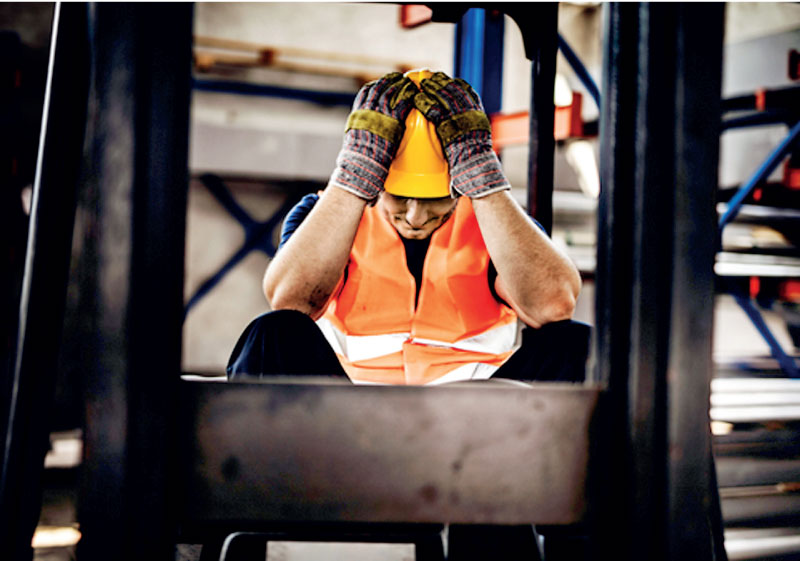Saturday Apr 19, 2025
Saturday Apr 19, 2025
Monday, 6 May 2024 00:00 - - {{hitsCtrl.values.hits}}

 Managing employee emotional stress is one of the most critical worldwide challenges facing the workplace today, and it has become particularly crucial in Sri Lankan workplaces. While the current trend has become critical, it is expected to worsen the situation. As the issue has become global, the International Labour Organisation (ILO) has disclosed that work-related stress experienced by employees annually costs the global economy over $ 1 trillion and causes the loss of 12 billion workdays. In terms of the size of the workforce, employment accounts for over 50% of the global population at present. According to the World Health Organization (WHO), 15% of working-age individuals in the world suffer from a mental disorder. Given these trends, both the ILO and the WHO have called for urgent measures to be taken to tackle mental health concerns that are prevalent among the employed demographic.
Managing employee emotional stress is one of the most critical worldwide challenges facing the workplace today, and it has become particularly crucial in Sri Lankan workplaces. While the current trend has become critical, it is expected to worsen the situation. As the issue has become global, the International Labour Organisation (ILO) has disclosed that work-related stress experienced by employees annually costs the global economy over $ 1 trillion and causes the loss of 12 billion workdays. In terms of the size of the workforce, employment accounts for over 50% of the global population at present. According to the World Health Organization (WHO), 15% of working-age individuals in the world suffer from a mental disorder. Given these trends, both the ILO and the WHO have called for urgent measures to be taken to tackle mental health concerns that are prevalent among the employed demographic.
The level of job stress experienced by employees in Sri Lanka has been reported to be worsening compared to many other countries. This troubling trend can be attributed to factors that may be unique to the socio-economic, political, and cultural landscape of Sri Lanka. A shocking finding from Gallup’s “State of the Global Workplace 2023 Report” is that employees in Sri Lanka are the most stressed out every day compared to workers in other South Asian countries (except Afghanistan). According to the Gallup Survey 2023, a significant number (58%) of respondents from Sri Lanka said they were stressed for most of the previous days. This represents a three-point increase during the last 2022 data. In comparison, it is worth noting that Bangladesh, Nepal, and Pakistan have reported far lower daily stress levels, with 41%, 34%, and 33%, respectively, while India’s workforce reported a stress level of 32%.
Not only does this number place Sri Lanka at the top of the stress rating, but it also makes clear that the country is becoming increasingly concerned about the health and safety of its workforce, employees’ mental health in particular. Because of the growth, it is clear that there is a trend that requires immediate attention from business leaders to address the factors contributing to the stress in workplaces. A recent survey of 1214 employees in Sri Lanka revealed a significant prevalence of moderate to high levels of stress among Sri Lankans. This emphasises the immediate requirement for stress management interventions to enhance resilience and the psychological well-being of Sri Lankan employees.
Need for new approaches and frameworks
Given the growing trends in stress and related psychosocial issues in workplaces, there is a need for new approaches and frameworks to alleviate them. Fundamental to these methods is the understanding that imbalances between the physiological demands of the workplace and the capacity of individual workers to meet those needs as it has now become a common source of stress in the workplace. This discrepancy can manifest due to several factors, including but not limited to high workloads, tight deadlines, insufficient resources, or lack of managerial support, contributing to an environment rife with pressure and anxiety. Other possible causes include the repercussions of economic crises, political instability, or social unrest. These underlying difficulties can create pervasive uncertainty and pressure in workers’ daily lives.
Hence, it is imperative for organisations to actively recognise and tackle these concerns, cultivating a conducive work environment that not only achieves production goals but also places emphasis on the emotional well-being of its workforce. Thus, firms must modify their management approach and explore novel tactics. For an organisation to flourish, employees must be psychologically fit by managing their level of stress so that they fulfil their formal job requirements and demonstrate prosocial behaviours, too.
Particularly in the manufacturing sector, employees frequently encounter obstacles that might lead to work-related stress due to the emphasis on consistent productivity and effectiveness. This can mean working long hours, meeting tight deadlines, and doing work that is often hard on the body. Workers in this field may also worry about their job security because the market’s needs change all the time, and there is a chance that jobs will be automated or outsourced. In addition, lack of freedom and autonomy, and repetitive tasks can make individuals less satisfied with their jobs and more stressed. Further, safety can be a significant issue in manufacturing settings, where accidents are more likely to occur due to using tools and machinery. This can be very stressful for workers, who may psychologically feel like they are always working in dangerous conditions.
Establishing a conducive climate
One of the principles that can address these issues is establishing a conducive climate in the organisation. An organisational climate that fosters support can be categorised as either safety-oriented or service-oriented. Manufacturing firms tend to prioritise establishing and maintaining a safety-oriented environment, recognising safety’s crucial role in enhancing their workforce productivity and overall performance. A safety-oriented climate ensures that workers are physically and emotionally healthy. Nevertheless, when companies care a lot about their workers’ emotional health, they are more likely to do good things for others and do a better job because they are less likely to experience stress, burnout, and mental health issues because of the perceived safe environment at work. Therefore, sustaining a supportive organisational environment in manufacturing firms is more important to mitigate employees’ emotional stress and psychosocial challenges.
Conversely, as manufacturing firms tend to embrace the integration of Artificial Intelligence and technological advancements, they progressively implement innovative organisational changes, often investing millions of rupees. These transformations aim to streamline operations, improve efficiency, and reduce the manual workload, potentially alleviating some of the stressors employees face. However, such shifts can lead to concerns about job displacement and require workers to adapt to new systems and working methods, which can also be a source of stress.
This transition demands financial investment and a commitment to retraining employees, nurturing adaptability, and managing the human side of change to ensure that the workforce is not only retained but also remains less stressed, engaged, and motivated. Therefore, when reconfiguring the workplace environment in manufacturing firms, it is essential to pinpoint and employ the right strategies to execute successfully while effectively managing and mitigating employee stress levels.
The Central Bank of Sri Lanka has also claimed that many countries experienced rapid growth after implementing robust manufacturing strategies in the middle of the 20th century, showing that the manufacturing sector can be a big part of a country’s economic and social change. The rise of the manufacturing industry could help eliminate poverty and regional inequality, make good jobs available, boost export earnings, and improve the economy’s technological and production skills to support growth. Since its economic liberalisation in 1978, Sri Lanka has had much success in terms of national wealth and better living standards. However, the manufacturing sector has not been as helpful to Sri Lanka’s economic growth as the service sector.
The World Bank also says Sri Lanka’s manufacturing industry has moved much more slowly than other South Asian countries. Bhutan and Afghanistan are the only two South Asian countries whose production sectors grew less than Sri Lanka’s from 2010 to 2021. Because of this, Sri Lanka’s manufacturing sector needs to find ways to boost its performance and the performance of its workers, especially by managing the stress and related psychosocial issues that come with the job.
At firm levels, business and human resources leaders are responsible for tackling manufacturing organisations’ rising employee job stress levels. Their duty includes identifying and implementing remedies and understanding the underlying reasons for such stress. It is appreciated that business leaders are considering making facilities for research and studies on this critical issue. This approach thoroughly examines working policies, employee relations, perceptions, expectations, and the impact of emerging technology on the workforce. They must evaluate how work is structured, the expectations made of individuals, and the support systems in place.
Thus, business and HR leaders must confront these challenges with empathy, strategic planning, and dedication to the long-term health and well-being of their employees and the organisation. This effort would help create a sustainable workplace where stress is managed and employee morale is prioritised alongside the bottom-line goals.
(The writer is a Doctoral Candidate, University of Wollongong, NSW, Australia. He holds an MLHRM, PgD. in HRM, BSc (Business Mgt.) Special, and is Chartered Member of CIPM, PMHRP, AMITD (SL). He can be contacted via [email protected]/[email protected].)